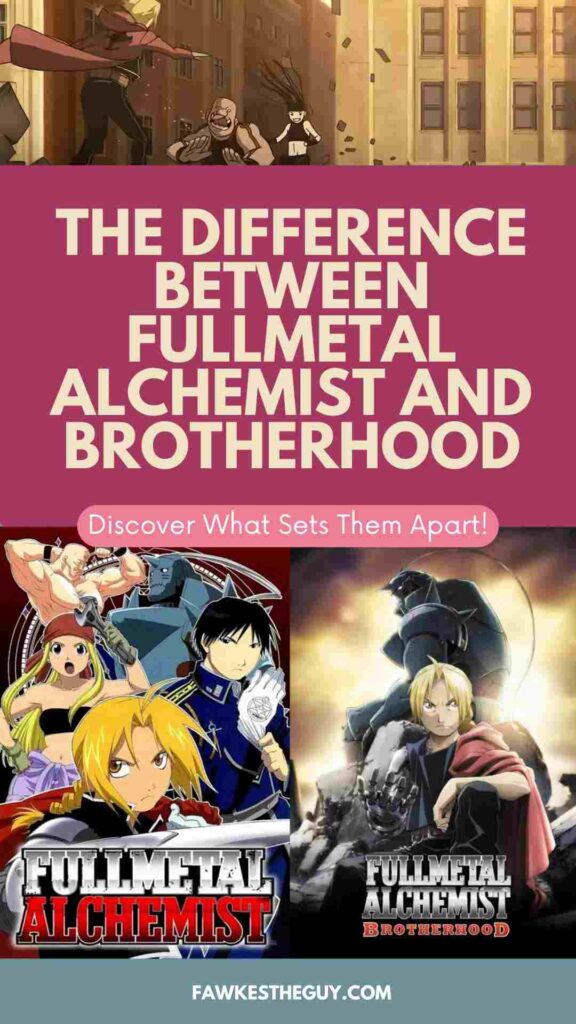If you’ve ever found yourself scratching your head when talking about Fullmetal Alchemist and Fullmetal Alchemist: Brotherhood, you’re not alone. Both versions of this iconic anime share the same premise, but they diverge in crucial ways. Whether you’re a long-time fan or someone just diving into the world of alchemy and military, understanding the differences between the two can help you appreciate each version in its own right.
In this article, I’ll break down what sets these two adaptations apart, from their story arcs to their pacing and even their endings. After all, as a Fullmetal Alchemist fan, understanding the nuances between the two series is essential—especially when you’re trying to explain the differences to friends who might not get it (like I did once!). Let’s dive in.
*Some resources in article are affiliate links. Full disclosure here.

Storyline Differences: Diverging Paths
While both Fullmetal Alchemist and Brotherhood start with the same premise—two brothers, Edward and Alphonse Elric, attempt to use alchemy to bring their mother back to life but suffer grave consequences—each series takes a different direction as the story unfolds.
The original Fullmetal Alchemist (2003) began airing before the manga was completed, so it eventually diverged from the manga’s storyline, creating its own unique world. Characters like Father, the main antagonist, and the storyline involving the Homunculi take a different, often darker turn.
On the other hand, Fullmetal Alchemist: Brotherhood (2009) sticks closely to the manga’s original plot, even introducing some new characters and events that weren’t part of the original anime. If you’re a stickler for following the manga’s path, Brotherhood is your go-to version, as it captures the full narrative arc as intended by Hiromu Arakawa.

Character Development: Who Gets More Screen Time?
When it comes to character development, both series do a great job of fleshing out key players, but there’s a notable difference in how much screen time certain characters get.
In the original Fullmetal Alchemist, the story allows for more exploration of the central characters’ internal struggles, as well as additional character arcs that aren’t present in Brotherhood. Characters like Roy Mustang, Winry Rockbell, and Maes Hughes get more depth in the first series, as it focuses more on their personal journeys.
Meanwhile, Brotherhood is more fast-paced, with a stronger emphasis on the plot and overarching goals of the Elric brothers. While it does explore the same characters, the character development tends to be more condensed, with less time to get into the intricate details of each person’s background.
Pacing: How Fast is Too Fast?
If you’re anything like me, pacing can make or break an anime experience. And there’s a stark contrast in pacing between the two versions. The original Fullmetal Alchemist tends to slow things down, especially in the first half. It’s more about building the emotional depth of the characters and letting their personal struggles resonate.
Brotherhood, on the other hand, is much quicker to get into the meat of the story. It picks up speed, moving through key events rapidly, especially when the Elric brothers confront the true villain of the series. While this faster pacing might be preferred by viewers who like action and progression, some fans of the original series feel it sacrifices some of the emotional weight that Fullmetal Alchemist delivered.
If you’re curious about how Fullmetal Alchemist fits into the world of shonen anime, don’t miss our deep dive into the genre here.
The Endings: A Matter of Preference
Now, this is where things get interesting. The endings of both series couldn’t be more different.
The original Fullmetal Alchemist offers a more open-ended and somewhat ambiguous conclusion. Given that the anime had to take its own path, the finale is a unique and emotional ending that stands on its own. For some, this feels like a satisfying conclusion, while others wish the series had followed the manga’s timeline.
In contrast, Brotherhood stays true to the manga, offering a more conclusive and direct ending that wraps up the entire story arc neatly. If you prefer a clear, epic conclusion, you might lean toward Brotherhood. But for those who appreciate a bit more mystery and a deeper exploration of sacrifice, the original Fullmetal Alchemist could be more your speed.
Conclusion: Why Understanding the Difference Matters
So, which version of Fullmetal Alchemist should you watch? It really depends on what you’re looking for. If you’re a stickler for the manga and want a more consistent plot with a satisfying ending, Brotherhood is the way to go. But if you appreciate an original storyline that takes its time with character development, then the original Fullmetal Alchemist might be a better choice.
Ultimately, both versions offer something unique to Fullmetal Alchemist fans, and there’s no right or wrong choice. After all, it’s about the journey—the brothers’ struggles, their growth, and their unbreakable bond. So, whether you’re just beginning your adventure in the world of Amestris or revisiting it for the umpteenth time, I hope this comparison helps you appreciate both versions for what they are.
If you haven’t seen both yet, maybe give them a try and see which one speaks to you more. As for me, I can never get enough of the Elric brothers and their incredible journey—no matter the version.
See you next week!

